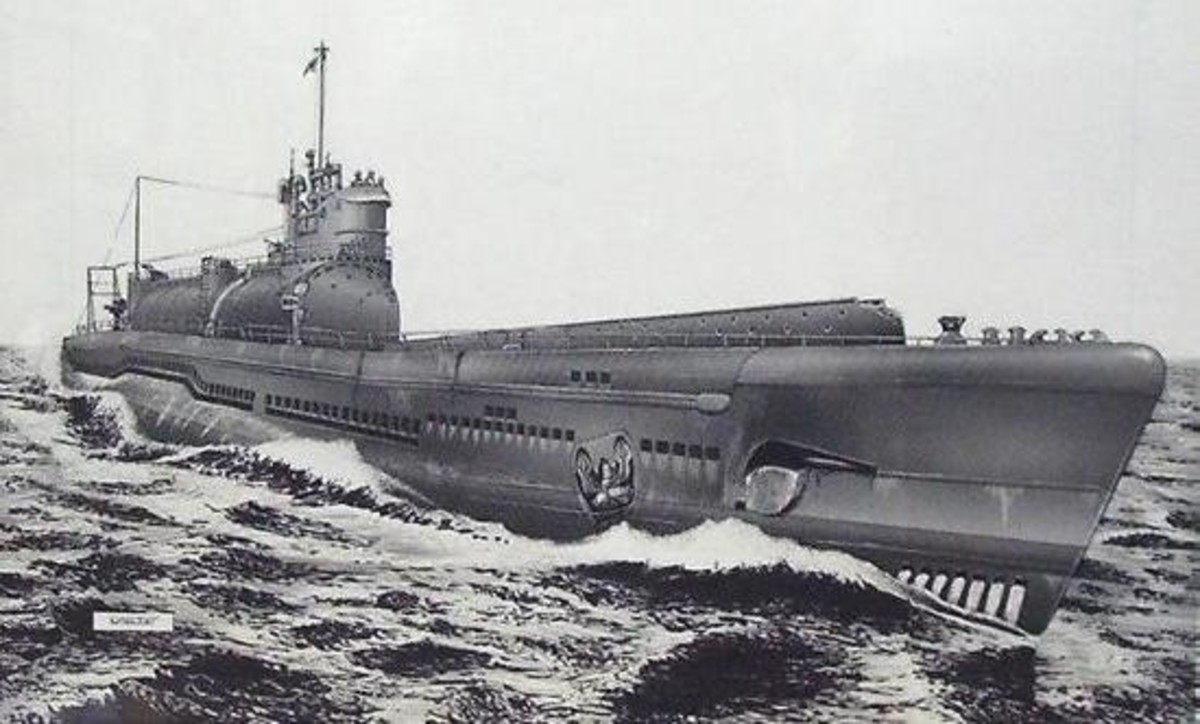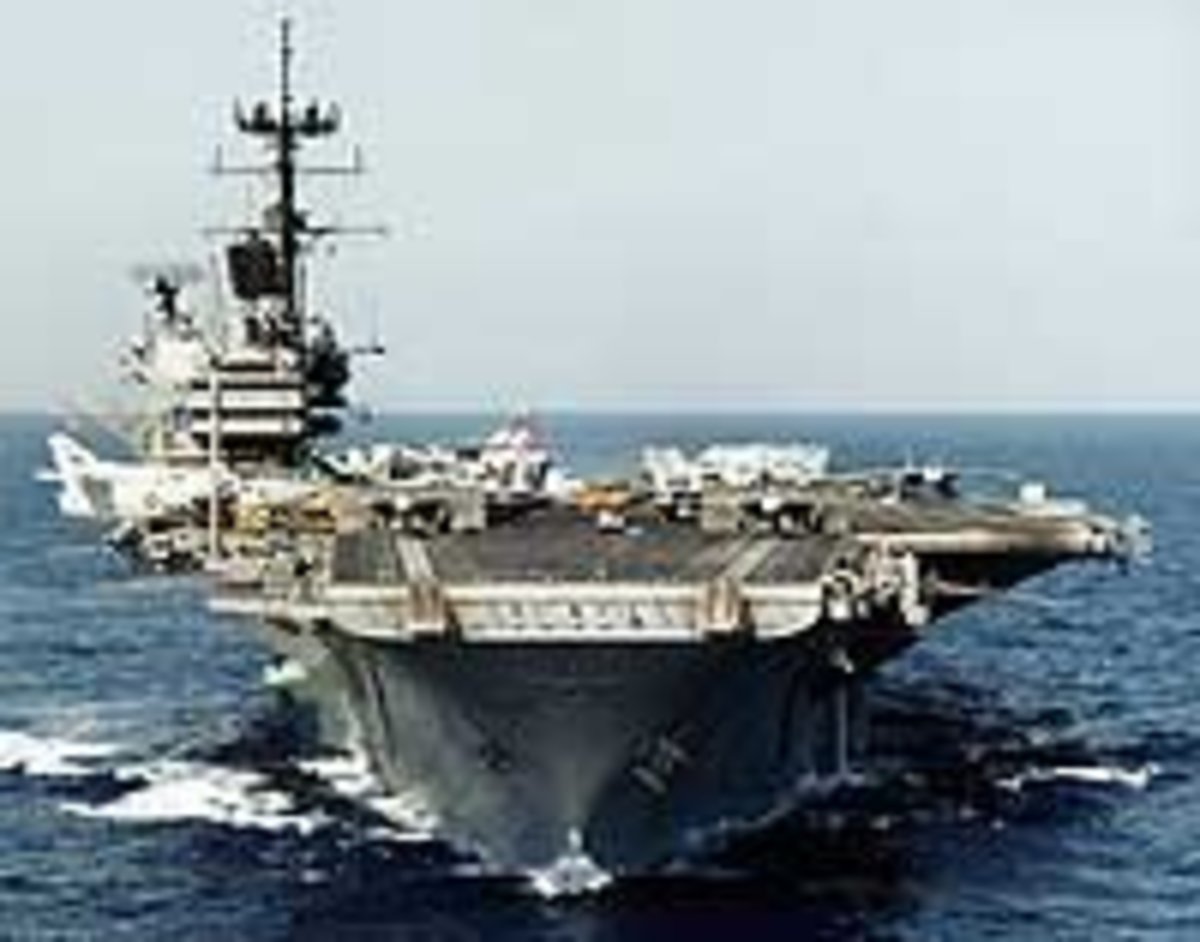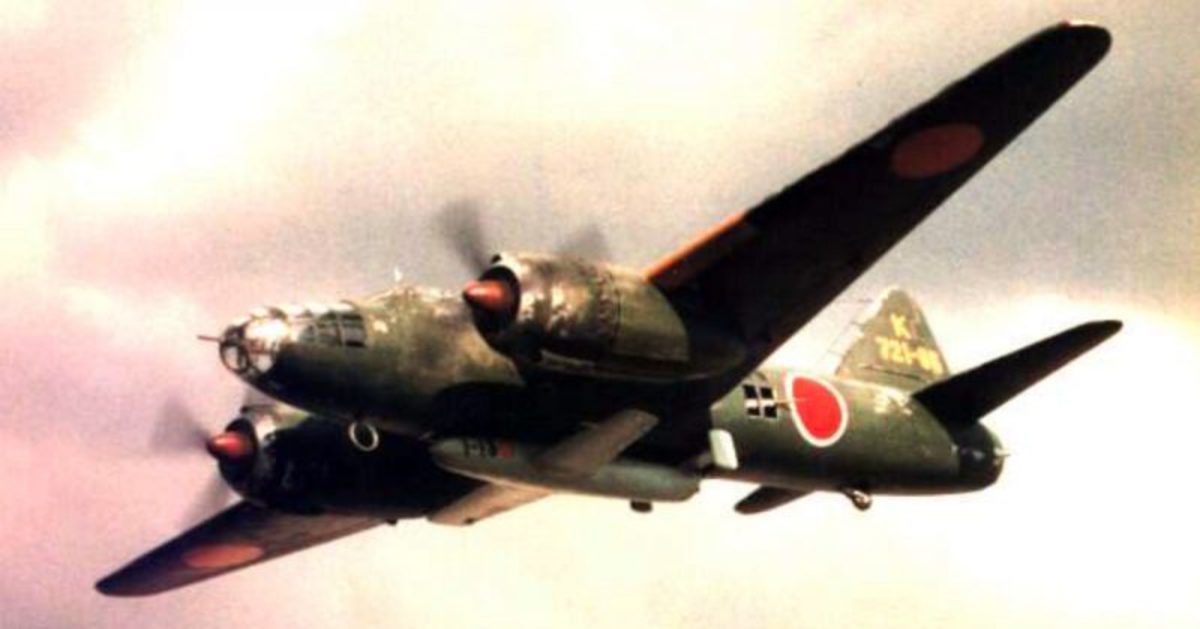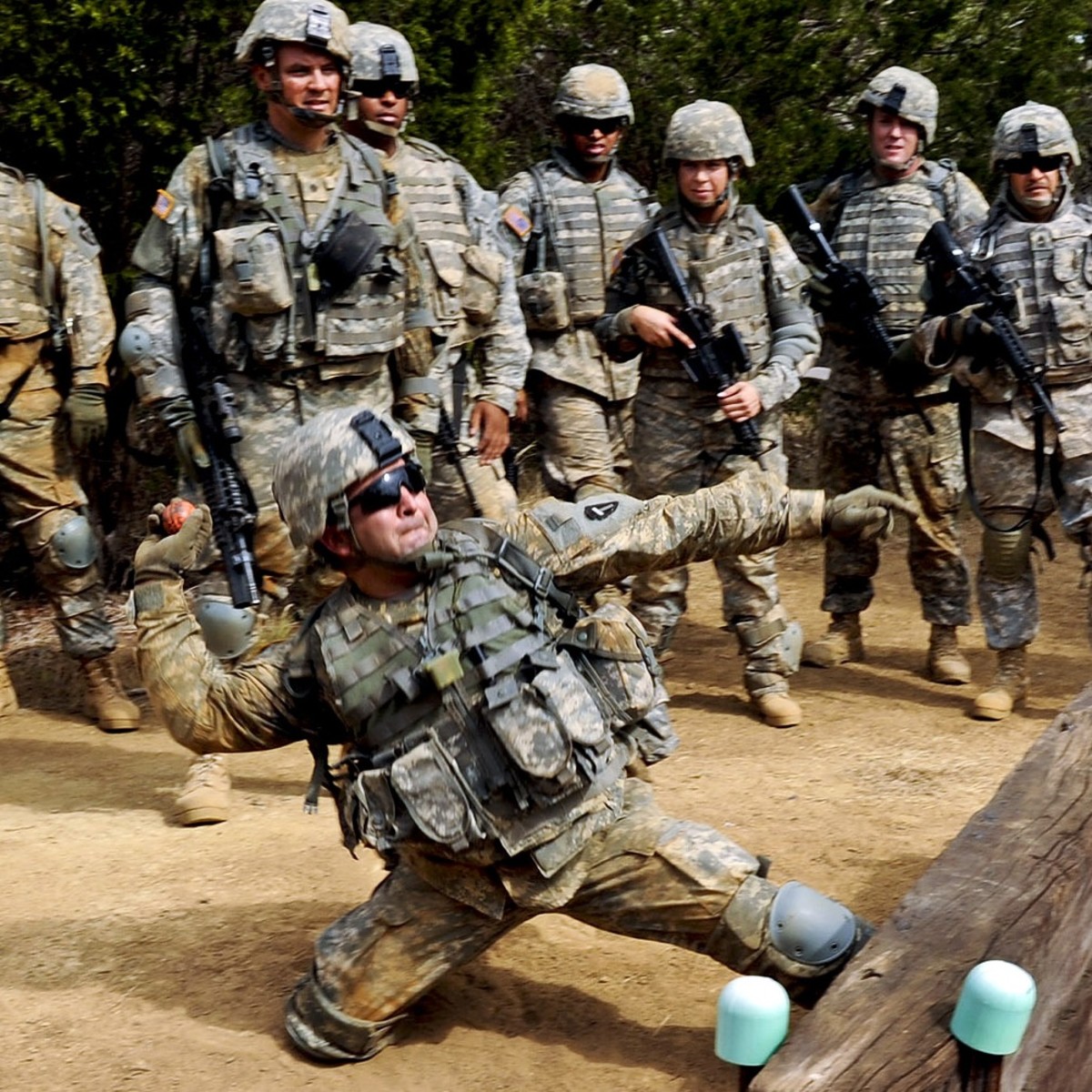Aircraft Carriers - Global Comparison
April 13, 2011
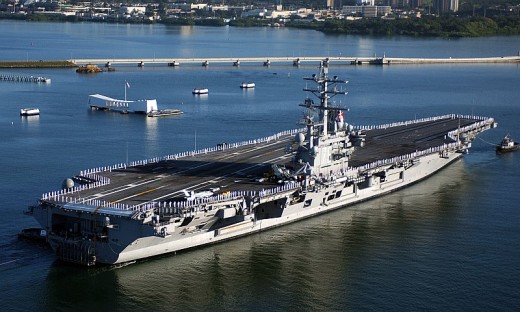
If your Dad was anything like my Dad, and I know many of them who were, he had a bookshelf full of military books; WWII, Vietnam War, books about battleships, etc. Going to air shows was one of our most popular outings. He used to build model airplanes in the basement. My favorite was a Corsair, whose wings actually folded up.
This matters only as a way of saying that I have a certain affinity for the military. I am also, not a pacifist, and yet I think we have come to a point where it is necessary to have a serious discussion about defense spending. Not just because of the fiscal situation we are in, but also for the simple fact that the world is changing (it's always changing, but I think this debate is late in coming).
Neither discussion about defense spending or about our role in the world can take place without talking about our aircraft carriers, which not only consume a substantial portion of the navies budget and manpower, but also very often serve as our ambassador in international affairs.
tons and tonnes
In America a ton is 2,000lbs. It is also called a short ton. Other parts of the world use the metric ton, also called a tonne or metric tonne, which equals 1,000 kilograms (≈2,204.62 lbs.). To add to the confusion, the British also have the long ton, which is equivalent to 2,240 lbs. However, as far as I can tell all ship measurements are in metric tons even if they are listed as tons. For the sake of clarity I am using the term tonne throughout.
Aircraft Carriers
Basically, all aircraft carriers are designed to do the same thing; to insert themselves into a hostile environment and destroy enemy assets, which
can include ships, air units, ground forces and infrastructure. Some carriers
are capable of effective actions against all of these targets, while others are
only effective against some of them. Some have additional capabilities such as amphibious operations or Anti-surface warfare.
Often times people talk about cutting military spending without seeming to know much about it. Such arguments tend to say that, our forces are a gazillion times more powerful than any potential competitor, therefore we should cut spending. Generally that argument is a bit too simplistic, but still, having some perspective on relative capabilities is important.
This article is going to present some statistics on aircraft carriers. I have limited this article to carriers because they are the primary ship in force projection fleets.
For the record, I don't know enough to make arguments for cutting defense spending with much authority. Yet, I think a discussion amongst amateur laypeople still has some usefulness.
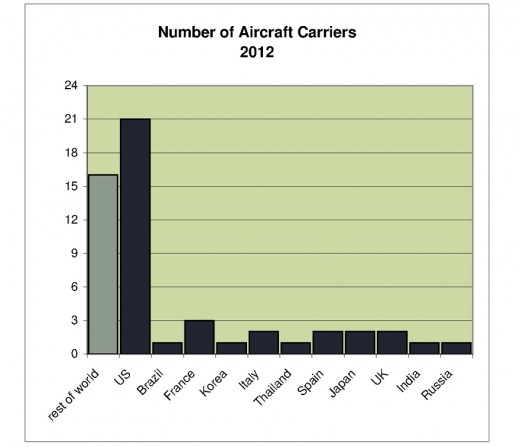
It is clear that the American fleet has a sizeable advantage. In fact it has the advantage even against the rest of the world combined. But, is it too great of an advantage? Is it a ridiculous advantage? It doesn't seem like it from numbers alone, but it is important to remember that not all carriers are created alike. American carriers are massive; each one weighing in around 100,000 tonnes. The largest carriers outside of the US are Russia's Admiral Flota Sovetskogo Soyuza Kuznetsov (55,000t) and France's Charles de Gaulle (42,000t). After those two, all other carriers are under 33,000t. The next graph compares the tonnage of carriers.
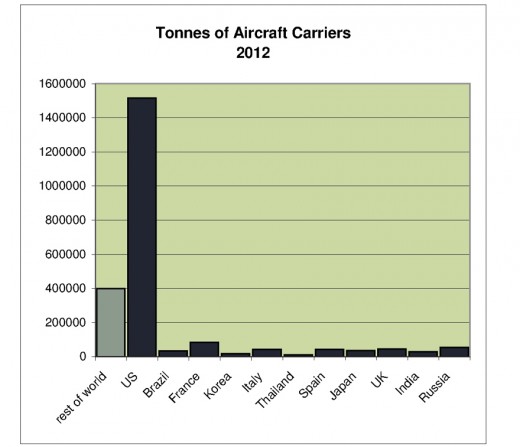
America has nearly four times the weight in carriers compared to the rest of the world combined. The only countries with carriers who can even be considered as potential adversaries are Russia and India, whose two carriers combined weigh less than a single American carrier. China, arguably the most likely future adversary doesn't have any operational carriers at all (that will change in the very near future). This graph begins to show the true disparity in world naval power. The next graph looks at the number of aircraft carried by national carrier fleets.
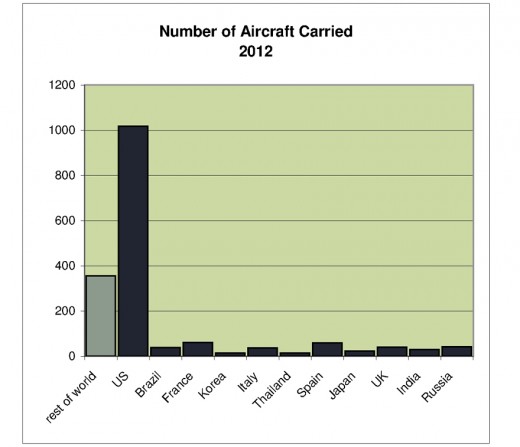
Looking at aircraft carried again shows America's clear mismatch. Not quite as overwhelming as tonnage but still significant. And just as carriers aren't created equal, aircraft aren't either. Of the carrier operating nations, only 4 operate carriers that can launch conventional aircraft, and of those only 3 launch 4th generation or higher aircraft. I might in a separate hub talk about the different types and generations of aircraft launched from carriers, but for now it is only important to understand that 4th generation conventional fighters are the most capable and powerful air superiority aircraft that can be launched from carriers. The graph below shows the global comparisons.
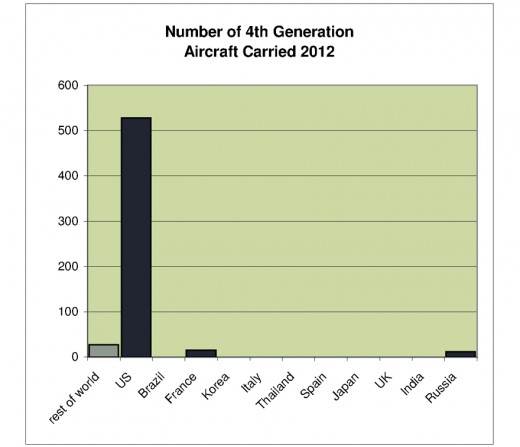
Anyone who pays attention to world naval issues knows that there are quite a few nations with plans to build carriers in the next decade. Most notably is probably China who has not only been expanding the size but also the quality of its naval forces. India, as well, as a rising power has plans of expanding its navy. Russia has plans to renew its old naval fleet, but it is uncertain whether they will have the funds to make much of an effort. Western countries, as well as Japan and South Korea all have plans for building new carriers. Let's take a look at what things may look like in 2020. Note that America will build 4 carriers, they are also going to retire three in that period, for a net gain of one.
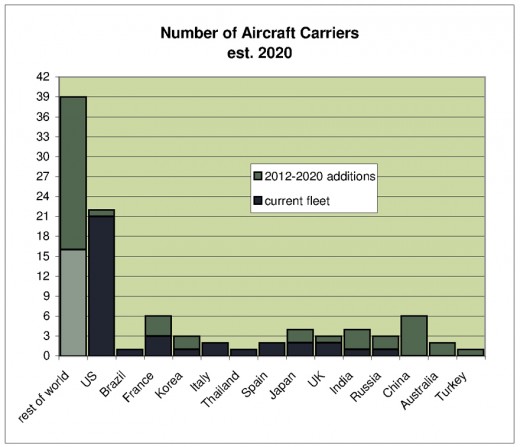
Looking at the numbers may seem a bit alarming, but again, a clearer perspective can be gotten by looking at the weight.
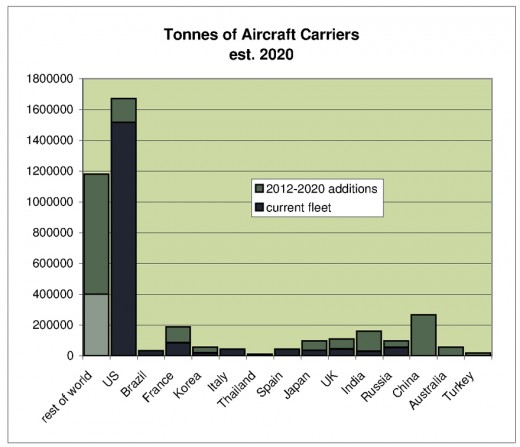
In terms of weight, America will still hold a clear advantage, even against the combined world. A couple things stand out in this graph. The more than doubling of carriers operated by other countries and the very sudden rise of China into second place. The graph below of aircraft carried shows a similar relationship.
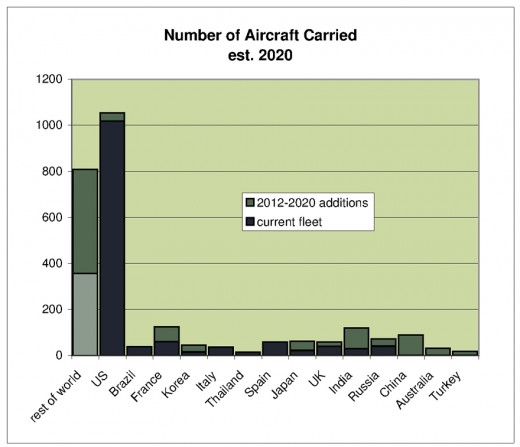
2020 Alternate Reality
Right now we operate three aircraft carriers for the purpose of patrolling the Mediterranean Sea, and another three to patrol the Western Pacific. While there is value in patrolling these areas it is debatable whether it is an expense we can and should afford. Why not shift these burdens and costs to allied countries in these regions.
Could we sell 3 carriers to Europe? Maybe not; even one would likely be a hard sell, but both France and Britain have plans for building large carriers in the next decade, so it does at least make some sense. These two carriers as well as some American units could form a joint force to continue to carry out a regional presence. A permanent European base could be established for this fleet.
The same thing could be done in the Western Pacific. Sell one carrier to both Japan and South Korea that along with a US unit would form a joint command naval force in the Western Pacific. We already have a permanent carrier strike group stationed in Japan that could possibly serve as the permanent base for this fleet.
Cutting the US carrier fleet down to 6-7 seems horrifying. Let's see what it would look like.
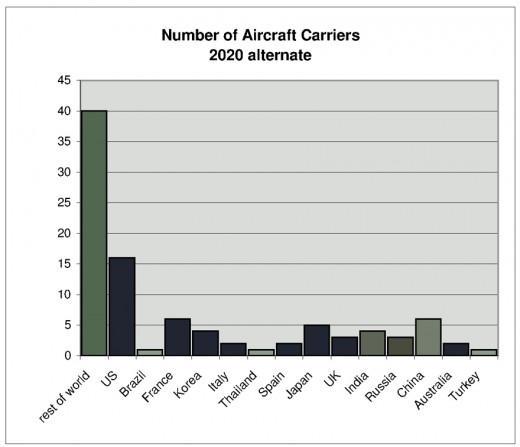
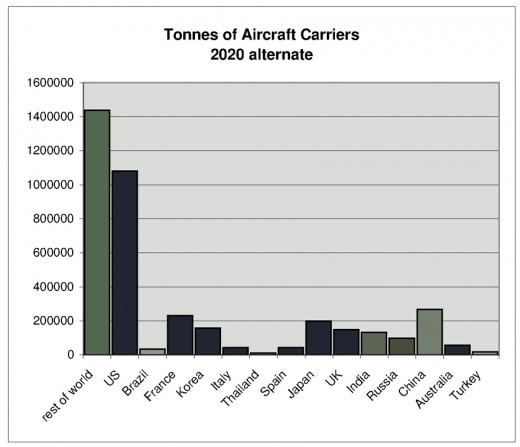
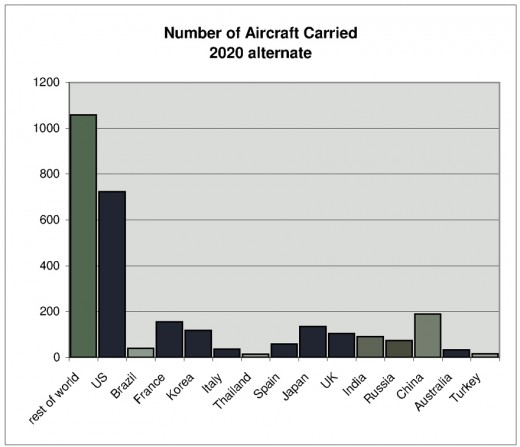
There is something uncomfortable about letting our position of dominance slide a bit. There is something uncomfortable about China getting any closer to parity.
Let's step back for a minute and really think about that. What is the point of the military in relationship to China? It isn't to invade them; that is never going to happen. And so the point is deterrence - it is essentially a big stick, right? It is us saying, "do as we say, or we will whack you." I know that is a terribly crude way of saying it, but essentially when you strip away any politeness that is what it is all about.
The question than is this; can we build and maintain a big enough stick to continue and frighten them? I think the answer is no. Given the trajectory of their economic and military development and the sheer size of their population, it is inevitable that our stick will eventually seem more like a twig.
But that is only in a China vs. US world, and that is a world that doesn't have to be. Part of the point of this alternate reality would be to shift the stick wielder away from America to a much broader alliance of democratic nations. Looking at the world from this perspective looks like this:
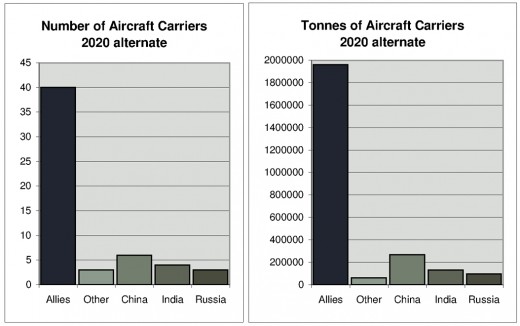
Half the fleet it used to be.
So why cut the fleet at all? First of course is expense. Nearly half of all navy personnel serve on Aircraft carriers, and personnel costs are a sizeable portion of the overall budget. Additionally, carriers are expensive, to build, operate, and to maintain. Also, along with the costs of the carriers comes the costs of the air wings they carry. The navy currently has more money budgeted for procuring aircraft than they do ships.
But, perhaps more important than cost, is the issue of flexibility. A 12 super-carrier fleet defines our navy and if we keep it that way, will define it for decades. But, if you ask a bunch of really smart navy guys what fleet we will needed in 10, 20, or 30 years, there is a good chance each one of them will give you a different answer. There is a great deal of geopolitical instability at the moment, and there are some potential game-changing technologies that may become operational in the next decade, so that is understandable. But, isn't there then value in flexibility rather than rigidity?
Hive Strike Groups
There are already a number of future ship programs which have been cut or delayed due to budgetary constraints. Freeing up resources by reducing the carrier fleet would allow for more research, development, and experimentation with future fleet vessels and future fleet doctrine and strategy.
One program which is going forward is the Littoral Combat Ship program (LCS). This ship is intended to operate in the littoral regions and has been designed with the modular ability to swap different mission modules in and out depending upon requirements.
As far as I can tell though, at the moment, this modularity is only strategic. The modules can only be swapped at naval bases. This doesn't make much sense to me. As an armchair general (which I am - actually I guess I am more of an armchair ensign) I would want the modularity to be tactical - meaning modules could be swapped out while on station, in a short period of time (half a day for instance). After all, isn't that kind of the point of having a forward presence is that we have the capacity to respond to previously unknown contingencies?
The first of the new America class amphibious ships is about to be commissioned. This vessel and the next in the class are being built without well-decks (used for launching and retrieving small water craft). Evidently, the navy has decided this is not an optimal configuration and the future vessels of this class after the first two are going to have well-decks.
Why not take these two ships, that aren't considered optimal for amphibious operations, and use them as hive ships. Instead of carrying marines and their equipment, they could carry LCS mission modules and support a small force of LCS ships.
Would it work? I don't really know, but then I am not sure if anyone really knows. That is kind of the point. The flexibility to try these types of things out seems worthwhile.
Future Fleet
the fleet would be converted into a 2-hub fleet - the Pacific Fleet and the Atlantic Fleet. Forward presence units could be based with the European and Asian fleets. Each fleet would contain nine strike groups; three Carrier Strike Groups, three Expeditionary Strike Groups, and three Hive Strike Groups. The current 12 Carrier Strike Groups would be cut in half. The 10 current Expeditionary Strike Groups would be cut to 6 and the amphibious carriers and marine units and equipment would be partially transferred to the new Hive Strike Groups or to pre-positioning forces.
Carrier Strike Group x 6
1 x Aircraft Carrier
1 x air defense cruiser/destroyer
2 X destroyers
Expeditionary Strike Group x 6
1 x LHA
1 x LPD
1 x LSD
1 x air defense cruiser/destroyer
2 X destroyers
Hive Strike Group x 6
1 x Hive ship
1 x air defense cruiser/destroyer
3 x LCS
6 x corvettes


